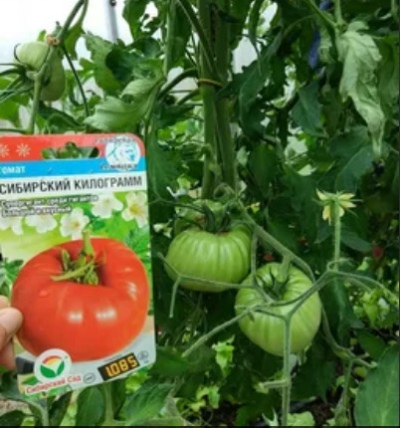
- Authors: Siberian selection
- Category: grade
- Appointment: fresh consumption, for juice, for ketchup and tomato paste
- Ripening period: mid-season
- Ripening time, days: 116-120
- Growing conditions: for open ground, for film greenhouses, for greenhouses
- Marketability: high
- Bush size: 180-200
- Bush characteristic: powerful
- Ripe fruit color: deep red, no green spot at the stalk
The Siberian kilogram tomato evokes positive expectations among many farmers. But only those who study all its subtleties can make their hopes come true. You should start by defining botanical characteristics.
Description of the variety
The Siberian kilogram tomato is a brilliant result of Siberian selection. This is precisely the variety in the botanical sense that allows you to successfully use your own seed material. Cultivation of the plant is possible both outdoors and under film protection. The height of the bushes ranges from 1.8 to 2 m. The bushes themselves are distinguished by powerful development.
The main qualities of the fruit
They are as follows:
ripe berries are deep red in color;
there will be no spots in the area of the stalk with a sufficient degree of ripeness;
tomatoes are very large, usually weighing 0.6-0.8 kg;
they are typically rounded geometric shapes;
3 or 4 fruits will appear in one hand.
Taste characteristics
This tomato is characterized by an expressive sweetness. Its pulp is always sugary. The official description also emphasizes its meatiness. The number of seeds is small, and they do not affect the taste. There is also no reason to doubt the juiciness of the fruit.
Ripening and fruiting
The Siberian kilogram is classified as a mid-season tomato. Under normal conditions of development, it will ripen in 116-120 days. Harvesting will be possible in July, August and September. However, it should be already traditionally emphasized that meteorological conditions and measures of plant care have a very strong influence.
Yield
The collection for 1 plant reaches 5 kg. In terms of 1 m2, it is equal to 26 kg. Therefore, the tomato is reasonably classified as an exceptionally productive crop.
The timing of planting seedlings and planting in the ground
Often, sowing seeds in containers with soil is done in March. But it is not shameful to do this during April as well. Seedlings are ready for transfer to free land in May or June. Then it will already be necessary to control the condition of the plants themselves.

Growing tomato seedlings is an extremely important process, because it largely depends on whether the gardener will be able to harvest at all. All aspects must be taken into account, from seedbed preparation to planting in the ground.
Landing scheme
The planting of the Siberian kilogram is recommended according to the 500x500 mm system. It is this procedure that is directly spelled out in the official instructions.

Growing and care
This culture can survive mild frosts calmly. However, it is most correct to protect it with a film after transplanting it into an open garden.It is necessary to remove the film only with full confidence that the bush has grown stronger. The most preferred method of growing seedlings. It will be possible to get a crop using a reckless method only in the southern regions of Russia, and even there any weather cataclysm can multiply all hopes by zero.
For sowing seedlings, it is recommended to use soil treated with potassium permanganate. Such processing must be carried out even for the substrate purchased in gardening stores. Watering both seedlings and adult plants should be regular. In this case, overflow is completely unacceptable. Seedlings should not suffer from crowding; other important conditions are intense lighting and mineral fertilization.
The picking of seedlings is done when real leaves are formed. Transfer should take place with a clod of earth. It is necessary to harden the seedlings, but only "without fanaticism." It is recommended to set up a garden bed in sunny places away from fruit trees and bushes. In cold areas, it is advisable to land in greenhouses or under temporary film shelters.




A plant needs different micronutrients at each stage of growth. All fertilizers can be divided into two groups: mineral and organic. Folk remedies are often used: iodine, yeast, bird droppings, eggshells.
It is important to observe the rate and period of feeding. This also applies to folk remedies and organic fertilizers.
Disease and pest resistance
Fruit cracking is not typical for the Siberian kilogram.


Resistant to adverse weather conditions
In the official description, resistance to temperature fluctuations is declared. But this does not mean at all that the variety will set records of protection from cold or heat. And the consequences for the quantity and quality of the crop will still manifest themselves. Therefore, it is better for gardeners to avoid extremes.
Growing regions
It is recommended to plant such tomatoes in all major regions of Russia. An exception is made only for the territories of the Far North and other particularly harsh areas.

























































































